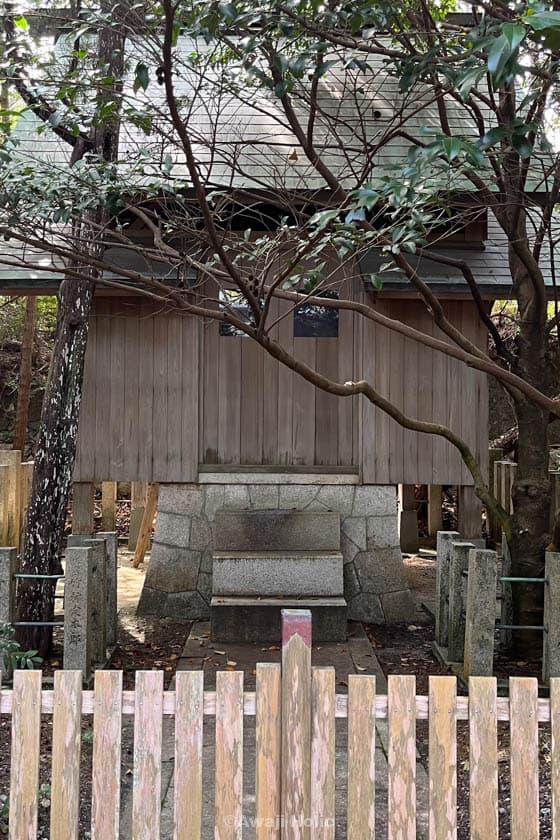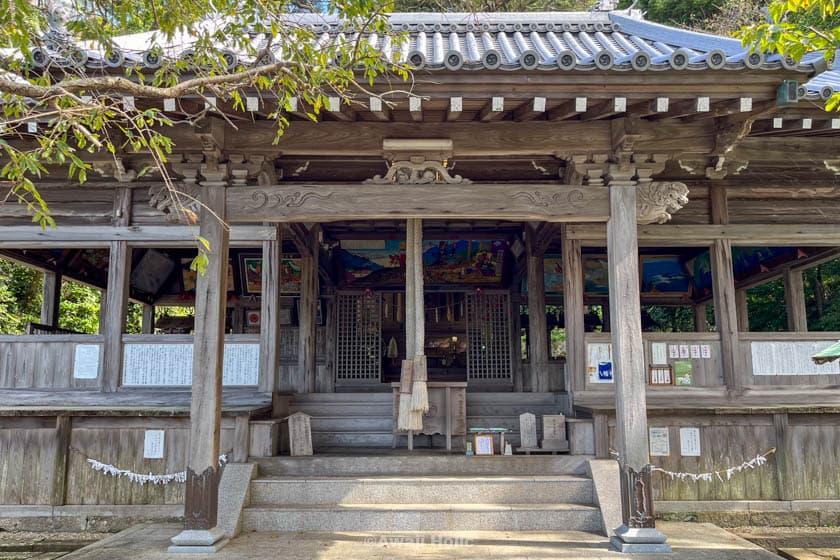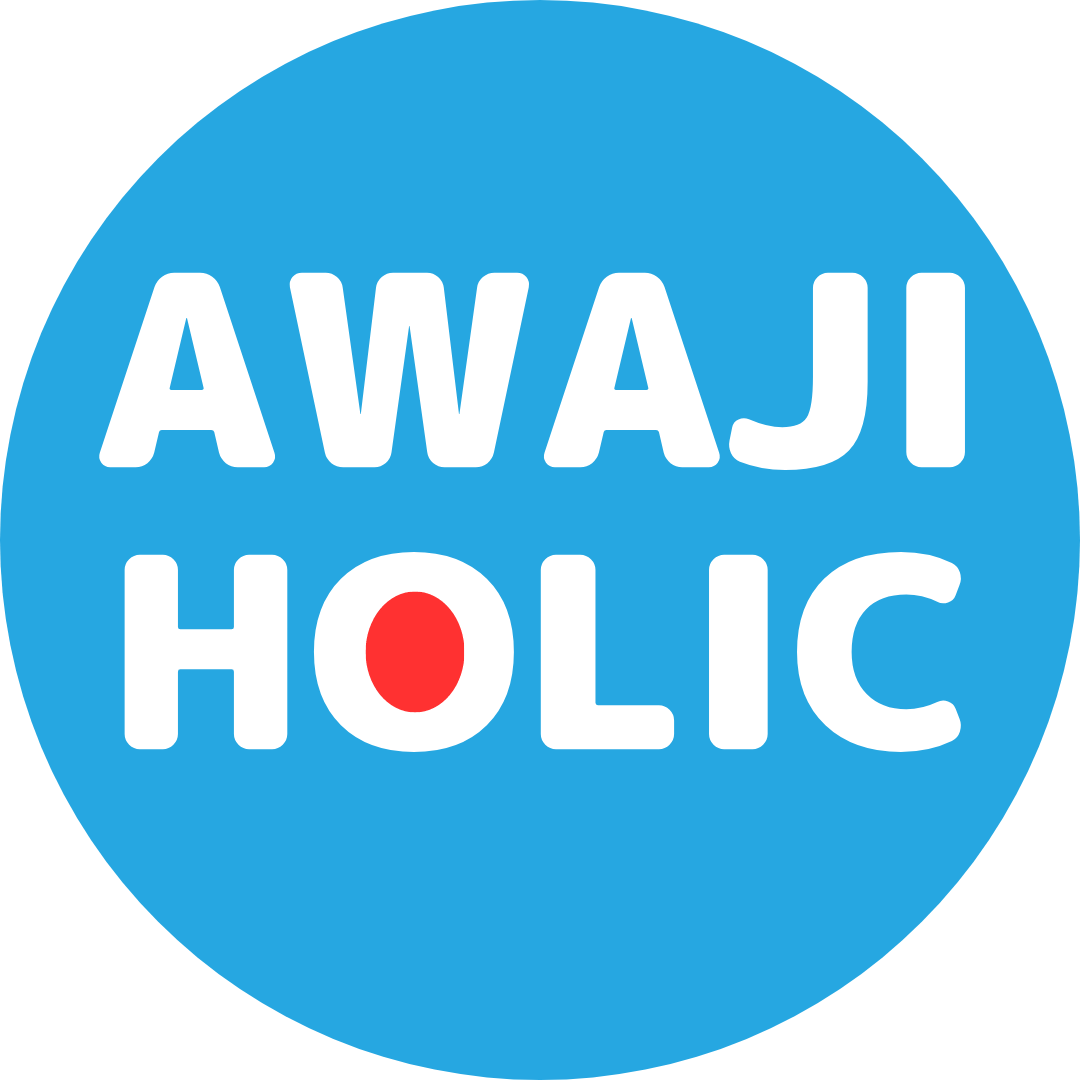Nushima, where the legend of Onokoro Island lives on, is believed to be the birthplace of the nation in Japanese mythology, and is the most likely of several possible sites on and off Awaji Island.
Nushima is dotted with many shrines and temples, including Onokoro Shrine, Benzaiten Shrine, Jinguji Temple, and Nushima Hachiman Shrine, and the island is also the site of lively local festivals such as the Spring Festival, Hamo no Kuyo Festival, and Bon Odori.
In addition, the island is a tourist destination where visitors can enjoy oddly-shaped rock cruises around the island, swimming in the sea, and fresh seafood dishes. Why not visit this island rich in tradition?
Contents
Tourist Attractions in Numajima
The three main tourist attractions of Nushima are as follows
- Kamitategami-iwa and Onokoro Shrine (myth of the birth of the nation: Onokoro Island)
- Nushima Beach
- Nushima Onokoro Cruise
Kamitategami-iwa and Onokoro Shrine (myth of the birth of the nation: Onokoro Island)

The symbol of Nushima is the 30-meter-high "Kamitategami-iwa" shaped like a spearhead. It is also said to be the "heavenly pillar" in the myth of the birth of the nation. In the center of the rock is a hollow in the shape of a heart. This dimple is popular as a symbol of marital bliss and the fulfillment of love.



Onokoro Shrine is known as the legendary site of Onokoro Island, which appears in the myth of the birth of the nation. The shrine, located on a small mountain, enshrines two deities, Izanagi and Izanami, the gods of creation, and the entire mountain is a sacred mountain called "Onokoro-san.
Numajima Beach
Located on a remote island with a circumference of 10 km, visitors can enjoy swimming in a relaxing, nature-rich environment. The beaches are characterized by sandy beaches and clear waters.

The opening was cancelled for the summer of 2023. We will keep you updated on the latest information as it becomes available.
| Swimming period | closed in 2023 |
| Facilities Shower | 1 (free), Changing room: 1 (free), Restroom: 1, Beach house: None |
| Prohibited | Fireworks, barbecue, marinesports, camping |
Nushima Onokoro Cruise
Onokoro Cruise operates the "Nushima Onokoro Cruise," in which fishermen who preserve the history and traditions of the Nushima Suigun navy circle Nushima in their own fishing boats. On this cruise, visitors can enjoy up-close views of the oddly shaped rocks of Numajima, which can only be seen from the sea.
Fare: 3,000 yen for adults, 1,500 yen for elementary school students, and free for children under elementary school age
Time: 50 minutes (open 9:00-17:00, almost every day of the week)
*A minimum of 7,000 yen is required for the operation.
Reservation:https://onoyamasuisan.blogspot.com/p/blog-page_18.html
Sights of Numajima
Other attractions on Nushima include.
Numajima Hachiman Shrine

Hachiman Shrine is dedicated to the god of good fishing. It is famous for the Danjiri Festival, which is held to pray for safety at sea and good catches of fish, and attracts many tourists. The forest on the hill behind the shrine is called Hachiman-san-no-mori (Hachiman's forest), and it is an untouched natural environment. Visitors can fully enjoy the abundant nature, with 200-year-old sudajii and tabunoki trees growing thickly.
Benzaiten Shrine
Benzaiten Shrine is worshipped as a god of maritime safety, a warrior god of war, and a guardian deity. The Benten of Nushima does not hold a biwa, but has eight arms on either side, and in his hands he holds a bow, sword, axe, snare, arrow, tridentegeki, dokko, and wheel, and sits on a wave-shaped pedestal with one leg raised. The temple is opened once every 100 years.
Jingu Shrine
真言宗の寺院である萬福寺は、元慶4年(880年)に創建されたと伝えられています。梶原氏の菩提寺であり、厨子や紺紙金泥経、曼荼羅などの数々の宝物は、梶原氏の寄進とされています。また、境内には司馬遼太郎氏の小説の一節が刻まれた石碑があります。
Yamanooo Shrine
Small vermilion torii gates, where fishermen pray for "safety at sea" and "good catches in all seasons," line the approach to the shrine. Every year on Coming-of-Age Day, a mochi (rice cake) throwing event is held. In the past, when there was little entertainment available, an athletic meet was held on a nearby mountain, where people gathered to enjoy themselves.
Kajiwara Gorinto (Tomb of Kajiwara no Kagetoki)
A pagoda made of pine and incense stone stands here. This pagoda is said to be the tomb of Kajiwara no Kagesutoki, and is believed to date from the early Kamakura period. Shoko-ishi is a type of tuff, so named because of its luster like the scent of pine needles.
Nushima(Jinguuji) Garden
The Nushima (Jinguji) Garden, said to have been created in the early Edo period (1658-1661), is a dry landscape garden with a built-up hill style, constructed on the steep hillside behind Hachiman Shrine. The technique of using many pieces of crystalline schist in a "human" shape, which is unique to Numajima, gives a powerful impression.
Hakkakuido
The octagonal well at the entrance to the Numajima Garden is called "O-river" because wells are called "rivers" in Numajima. The "O-river" has long been used by many people in Numashima, where groundwater is abundant. Even today, the clean groundwater continues to gush out without drying up.
Restaurants and Accommodations in Nushima
Fisherman's Restaurant Asayama
Asayama is a restaurant run by fishermen. It has a reputation for serving the freshest seafood from Numajima.
In summer, fatty hamo dishes are popular. You can taste a variety of dishes such as hamo sashimi, grilled fish, and boiled fish. In winter and spring, visitors can enjoy seasonal seafood such as Thai dishes, crab dishes, and hot pots. Dishes using high-end ingredients such as Thai prawns and crabs are also popular.
The restaurant has three rooms that can accommodate up to 15 people.
WEB:-
TEL:0799-57-0920
ADD:206 Numajima, Minami-Awaji City, Hyogo Prefecture
Ryokan Kimuraya
Kimuraya is a ryokan where you can enjoy seasonal seafood dishes.
During the summer season, many visitors come to enjoy the fatty hamo (Japanese conger eel) dishes. You can enjoy a variety of dishes such as sashimi, grilled or boiled hamo (conger eel).
Not only meals but also overnight stays are available.
WEB:http://www.nushima-kimuraya.com/index.html
TEL:0799-57-0010
ADD:899 Numashima, Minami-Awaji City, Hyogo Prefecture
Guest House & Restaurant Shirazaki
Shirasaki is a restaurant with a guest house attached.
During the summer season, the restaurant's main dish is a popular course of hamo sukiyaki, a dish in which hamo (conger eel) is cooked with fatty hamo (conger eel). The chef pays special attention to the hamo bones and the broth, so you can enjoy the fluffy meat and rich flavor of the hamo. We also offer a wide variety of fresh, seasonal local fish dishes.
Because Numajima is surrounded by rich seas, you can also enjoy high-end fish such as sea bream, flatfish, and tuna.
Not only meals but also overnight stays are available.
WEB:http://www17.plala.or.jp/shirasaki/
TEL:0799-57-0443
ADD:824 Numashima, Minami-Awaji City, Hyogo Prefecture
Seafood Fisherman's Cuisine Suigun

Seafood Fisherman's Cuisine Suigun in Numashima is a seafood restaurant run by bottom trawl fishermen. It has a counter and a tatami room, and can accommodate up to 30 people. The restaurant serves mainly fish caught that day. You can also enjoy the island's sunset from the rooftop.
WEB:https://www.nushima-suigun.com/
TEL:0799-57-0338
ADD:2402 Numashima, Minami-Awaji City, Hyogo Prefecture
Events on Nushima
Five main festivals are held each year until the main
January 6:Yamanojin Festival
March 3 of lunar calendar:Hirabae Festival
May 3 and 4:Nushima Hachiman Shrine Spring Festival
Around May:Hamo (pike conger) Memorial Service
August 13-17:Bon dance
Nushima Hachiman Shrine Spring Festival
The Spring Festival, held annually on May 3 and 4 at Numashima Hachiman Shrine, is a heroic festival reminiscent of the Numashima Suigun (navy).
The highlight of the festival is the "Hiki-Danjiri," which is pulled while singing a Danjiri song to pray for a big catch, and the "Kaki-Danjiri," which is carried by the floats. The sight of the pulling Danjiri sliding into the sea with a spray of water is breathtaking. The kaki-danjiri parades with a lively rhythm, attracting spectators.
Another highlight of the festival is the Mikoshi, a portable shrine held high in the air. The portable shrines are paraded through the streets with the powerful shouts of the bearers.
Conger Eel Commemoration Festival
"The 'Conger Eel Memorial Festival' is held annually around May. This festival celebrates the arrival of the conger eel fishing season on Numajima, expressing gratitude for the blessings of the eels and praying for a bountiful catch and prosperous business.
On the day of the festival, a ceremony for the conger eel's memorial takes place at Saikoji Temple on Numajima. Subsequently, participants aboard boats release conger eels into the sea, praying for a successful fishing season.
The waters around Numajima are rich in mud and sand at the seabed, creating an ideal environment for conger eel growth. During the summer season, tourists visit to savor Numajima's conger eel dishes.
Numajima's conger eels are known for their thin skin, tender flesh, and rich fat content. Particularly during the rainy season from June to July, they are considered most delicious when the fat content is at its peak."
Bon Festival dance
The Bon Odori dance is held every year from August 13 to 17. Dancers in yukata (summer kimono) or wearing hanagasa (hats) dance to the tune of "Hyogo Kuchisetsuki," a Bon Odori song unique to Numashima.
Hyogo Kuchisetsuki" is a traditional Bon Odori song of Numashima, based on Joruri and Kabuki plays. Dancers spin around and dance to the tune of "Hyogo Kuchisetsuki," sung by an ondori (a dancer with an umbrella).
The Bon Odori dance lasts from around 9:00 p.m. until midnight, and is held every night for five days starting on August 13, with five wards of the island participating on a daily basis at the plazas and other locations within their wards.
Yama No Kami Festival
Yama No Kami Festival," held annually on January 6, is a festival dedicated to the guardian god of the Numajima naval force, the mountain god.
On the day of the festival, islanders and tourists gather to offer red fish, red rice, fried tofu, and other offerings to the shrine to pray for a big catch and safety at sea. Afterwards, portable shrines and danjiris parade through the town, and finally a mochi-maki (rice cake throwing) ceremony is held.
During the Mochimaki, red and white rice cakes are scattered about, with everyone aiming for the "tenmochi," which are only available in two portions and are larger than a person's face. The person who gets the "Tenmochi" is considered a "lucky man" or "lucky woman.
The day before the festival, a group of caretakers called the Yamakamigumi pound rice cakes to make mochi for the festival.
Hira Bae Festival
The "Hirabae Festival" is held every year on March 3 of the lunar calendar on Nushima. In this festival, a fishing boat makes three rounds of "Hirabae," a rocky reef on Nushima, to pray for safety at sea and a good catch.
In the old days, people used to climb up to the flat fly with a priest or priestess and pray by reciting a prayer and chanting a sutra. After praying, fishermen would drink sake on the spot to pray for a good catch.
Nowadays, the representative boat of each district is decorated with the district's big catch flag, and the boat heads to Hirabae in a heroic parade. The participants then drink sake and pay their respects on board the boat.
How to get to Nushima

You can reach Nushima by boat (10 minutes) from the Nushima Steamship Terminal at Nada-Habu Port on Awaji Island.
If you are going to Nada-Habu Port where Nushima Kisen is located by other than car, a cab is recommended. If you prefer to take a bus, use the Awaji Island Bus Search "Busmo"(Only Japanese) and search for the departure point "Your Bus Stop" → arrival point "Habu Port".
Nushima Kisen Timetable
Numashima Kisen operates daily.
| Nada Line(Nushima→Habu) | Nada Line(Habu→Nushima) | ||||
|---|---|---|---|---|---|
| No | From Nushima | Arrival at Habu | No | From Habu | Arrival at Nushima |
| 1 | 6時20分 | 6時30分 | 1 | 7時00分 | 7時10分 |
| 2 | 7時25分 | 7時35分 | 2 | 7時50分 | 8時00分 |
| 3 | 8時30分 | 8時40分 | 3 | 9時00分 | 9時10分 |
| 4 | 9時50分 | 10時00分 | 4 | 10時30分 | 10時40分 |
| 5 | 11時20分 | 11時30分 | 5 | 11時55分 | 12時05分 |
| 6 | 13時20分 | 13時30分 | 6 | 13時50分 | 14時00分 |
| 7 | 14時40分 | 14時50分 | 7 | 15時10分 | 15時20分 |
| 8 | 15時50分 | 16時00分 | 8 | 16時30分 | 16時40分 |
| 9 | 17時40分 | 17時50分 | 9 | 18時05分 | 18時15分 |
| 10 | 18時30分 | 18時40分 | 10 | 19時00分 | 19時10分 |
Nushima Kisen's Fare Chart
| Adult | Child | Hand Luggage | ||
|---|---|---|---|---|
| Nada Line (Nushima↔Habu) | One way trip ticket | 480円 | 240円 | 280円 |
| Round trip ticket | 920円 | 460円 |
Numashima Kisen Parking Lot
There is a parking lot next to the Nushima Kisen boarding gate. Parking is free within 30 minutes or 500 yen/24 hours.
Numashima Kisen Inquiries
Nushima Kisen Co.
Head Office: 0799-57-0008
Dojo Sales Office: 0799:56:0644
Nushima Basic Information
| Name | Nushima |
| Address | Numashima, Minami-Awaji City, Hyogo Prefecture |
| Phone | 0799-57-0001 |
| Official WEB | https://nushima-yoshijin.jp/ |
| Opening hours | - |
| Closed | - |
| Admission | Free |
| Parking | 50 cars |
| Parking fee | 500 yen / 24 hours |
| Access | By boat: 10 min. from Dojo Port by Numashima Steamship. |



